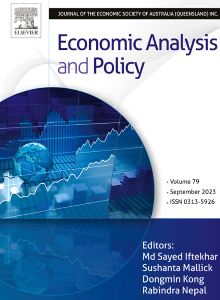人工智能与企业绿色创新:来自中国机器人应用的经验证据
IF 8.7
2区 经济学
Q1 ECONOMICS
引用次数: 0
摘要
在推动全球智能发展的过程中,以智能为驱动的企业生产方式的转变可以提升绿色制造。基于多源异构数据,研究了智能化发展对中国企业绿色创新的影响。研究表明,企业的绿色创新显著受益于智能发展,在考虑内生性问题和一系列稳健性分析的情况下,这一结论仍然成立。异质性分析表明,智能发展对国有企业、市场集中度较高的企业和中西部地区企业绿色创新的影响更为明显。机制分析表明,智能化可以扩大生产规模,优化要素配置,促进研发投资。通过规模效应、配置效应和研发效应,可以提高企业的绿色创新能力。溢出效应分析表明,智能发展对绿色创新的提升不仅由上游产业向下游产业溢出,而且由下游产业向上游产业溢出;产生了联动效应,促进了上下游企业之间的协同创新。本文章由计算机程序翻译,如有差异,请以英文原文为准。
Artificial intelligence and firm green innovation: empirical evidence from the application of robots in China
In promoting the development of intelligence worldwide, the transformation of enterprise production modes driven by intelligence can improve green manufacturing. The impact of intelligent development on Chinese enterprises’ green innovation are investigated based on multisource heterogeneous data. Research shows that the green innovation of firms significantly benefits from intelligent development, and this conclusion is still valid when the endogeneity problem and a series of robustness analyses are considered. The heterogeneity analyses reveal that the effect of intelligent development on green innovation is more obvious for state-owned enterprises, enterprises with high market concentrations, and firms in the central and western regions of China. The mechanism analyses indicate that intelligence can expand production scales, optimize the allocation of factors, and promote R&D investment. Through the scale effect, allocation effect, and R&D effect, enterprises' green innovation can be improved. The analyses of the spillover effect show that the improvement of green innovation through intelligent development not only overflows from upstream to downstream industries but also overflows from downstream to upstream industries; a linkage effect is created, which fosters collaborative innovation between upstream and downstream firms.
求助全文
通过发布文献求助,成功后即可免费获取论文全文。
去求助
来源期刊

Economic Analysis and Policy
ECONOMICS-
CiteScore
9.80
自引率
9.20%
发文量
231
审稿时长
93 days
期刊介绍:
Economic Analysis and Policy (established 1970) publishes articles from all branches of economics with a particular focus on research, theoretical and applied, which has strong policy relevance. The journal also publishes survey articles and empirical replications on key policy issues. Authors are expected to highlight the main insights in a non-technical introduction and in the conclusion.
 求助内容:
求助内容: 应助结果提醒方式:
应助结果提醒方式:


